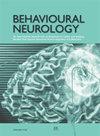Relationships between Personality Traits and Brain Gray Matter Are Different in Risky and Non-risky Drivers
IF 2.7
4区 医学
Q2 CLINICAL NEUROLOGY
引用次数: 1
Abstract
Personality traits such as impulsivity or sensitivity to rewards and punishments have been associated with risky driving behavior, but it is still unclear how brain anatomy is related to these traits as a function of risky driving. In the present study, we explore the neuroanatomical basis of risky driving behavior and how the level of risk-taking influences the relationship between the traits of impulsivity and sensitivity to rewards and punishments and brain gray matter volume. One hundred forty-four participants with different risk-taking tendencies assessed by real-life driving situations underwent MRI. Personality traits were assessed with self-report measures. We observed that the total gray matter volume varied as a function of risky driving tendencies, with higher risk individuals showing lower gray matter volumes. Similar results were found for volumes of brain areas involved in the reward and cognitive control networks, such as the frontotemporal, parietal, limbic, and cerebellar cortices. We have also shown that sensitivity to reward and punishment and impulsivity are differentially related to gray matter volumes as a function of risky driving tendencies. Highly risky individuals show lower absolute correlations with gray matter volumes than less risk-prone individuals. Taken together, our results show that risky drivers differ in the brain structure of the areas involved in reward processing, cognitive control, and behavioral modulation, which may lead to dysfunctional decision-making and riskier driving behavior.风险和非风险司机的人格特征与脑灰质的关系不同
冲动或对奖惩的敏感性等性格特征与危险驾驶行为有关,但目前尚不清楚大脑解剖结构与这些特征在危险驾驶中的关系。在本研究中,我们探讨了危险驾驶行为的神经解剖学基础,以及冒险水平如何影响冲动性和对奖惩的敏感性特征与大脑灰质体积之间的关系。通过真实驾驶情况评估,144名具有不同冒险倾向的参与者接受了核磁共振成像。人格特征通过自我报告测量进行评估。我们观察到,总灰质体积随着风险驾驶倾向的变化而变化,风险较高的人表现出较低的灰质体积。对于参与奖赏和认知控制网络的大量大脑区域,如额颞叶、顶叶、边缘和小脑皮层,也发现了类似的结果。我们还表明,对奖惩的敏感性和冲动性与灰质体积有不同的关系,灰质体积是危险驾驶倾向的函数。与风险较低的个体相比,高风险个体与灰质体积的绝对相关性较低。总之,我们的研究结果表明,风险驾驶员在参与奖励处理、认知控制和行为调节的区域的大脑结构不同,这可能导致决策功能失调和风险较高的驾驶行为。
本文章由计算机程序翻译,如有差异,请以英文原文为准。
求助全文
约1分钟内获得全文
求助全文
来源期刊

Behavioural Neurology
医学-临床神经学
CiteScore
5.40
自引率
3.60%
发文量
52
审稿时长
>12 weeks
期刊介绍:
Behavioural Neurology is a peer-reviewed, Open Access journal which publishes original research articles, review articles and clinical studies based on various diseases and syndromes in behavioural neurology. The aim of the journal is to provide a platform for researchers and clinicians working in various fields of neurology including cognitive neuroscience, neuropsychology and neuropsychiatry.
Topics of interest include:
ADHD
Aphasia
Autism
Alzheimer’s Disease
Behavioural Disorders
Dementia
Epilepsy
Multiple Sclerosis
Parkinson’s Disease
Psychosis
Stroke
Traumatic brain injury.
 求助内容:
求助内容: 应助结果提醒方式:
应助结果提醒方式:


